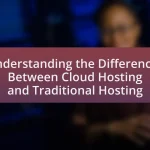Cloud hosting security encompasses the measures and protocols designed to protect data, applications, and infrastructure within cloud environments. This article outlines the critical components of cloud hosting security, including data encryption, access controls, and regular security audits, which collectively safeguard against unauthorized access and data breaches. It emphasizes the importance of implementing robust security practices to mitigate risks, comply with regulations, and protect sensitive information. Additionally, the article discusses common threats to cloud security, best practices for enhancing security measures, and the role of continuous monitoring and auditing in maintaining a secure cloud environment.
What is Cloud Hosting Security?
Cloud hosting security refers to the measures and protocols implemented to protect data, applications, and infrastructure hosted in cloud environments. This security encompasses various aspects, including data encryption, access controls, and regular security audits, to safeguard against unauthorized access, data breaches, and other cyber threats. According to a report by McAfee, 52% of organizations experienced a cloud security incident in the past year, highlighting the critical need for robust security practices in cloud hosting.
How does Cloud Hosting Security protect data?
Cloud Hosting Security protects data through multiple layers of security measures, including encryption, access controls, and regular security audits. Encryption safeguards data both at rest and in transit, ensuring that unauthorized users cannot access sensitive information. Access controls restrict data access to authorized personnel only, minimizing the risk of data breaches. Regular security audits help identify vulnerabilities and ensure compliance with security standards, further enhancing data protection. These practices collectively create a robust security framework that mitigates risks associated with data storage and transmission in cloud environments.
What are the key principles of Cloud Hosting Security?
The key principles of Cloud Hosting Security include data encryption, access control, regular security audits, and compliance with regulations. Data encryption protects sensitive information both at rest and in transit, ensuring that unauthorized users cannot access it. Access control mechanisms, such as multi-factor authentication and role-based access, limit user permissions and enhance security. Regular security audits help identify vulnerabilities and ensure that security measures are effective. Compliance with regulations, such as GDPR or HIPAA, ensures that cloud services meet legal standards for data protection, thereby reinforcing trust and accountability in cloud hosting environments.
How do encryption and access controls enhance security?
Encryption and access controls enhance security by protecting sensitive data from unauthorized access and ensuring that only authorized users can access specific information. Encryption transforms data into a coded format that can only be read by someone with the correct decryption key, making it significantly harder for attackers to exploit the data even if they gain access to it. Access controls, on the other hand, establish permissions and restrictions for users, ensuring that individuals can only access the data necessary for their roles. According to a 2020 report by the Ponemon Institute, organizations that implement strong encryption and access controls experience 50% fewer data breaches compared to those that do not. This demonstrates that both encryption and access controls are critical components in a comprehensive security strategy, particularly in cloud hosting environments where data is often stored and transmitted over the internet.
Why is Cloud Hosting Security important for businesses?
Cloud Hosting Security is crucial for businesses because it protects sensitive data from unauthorized access and cyber threats. With the increasing reliance on cloud services, businesses face heightened risks of data breaches, which can lead to financial loss, reputational damage, and legal consequences. According to a report by IBM, the average cost of a data breach in 2021 was $4.24 million, underscoring the financial implications of inadequate security measures. Furthermore, robust cloud security protocols help ensure compliance with regulations such as GDPR and HIPAA, which mandate strict data protection standards. Therefore, implementing effective cloud hosting security is essential for safeguarding business assets and maintaining customer trust.
What risks do businesses face without proper security measures?
Businesses face significant risks without proper security measures, including data breaches, financial loss, and reputational damage. Data breaches can lead to unauthorized access to sensitive information, resulting in the theft of customer data or intellectual property. According to a report by IBM, the average cost of a data breach in 2023 was $4.45 million, highlighting the financial implications of inadequate security. Additionally, businesses may experience operational disruptions due to cyberattacks, which can halt services and lead to further financial losses. Reputational damage can also occur, as customers may lose trust in a company that fails to protect their data, potentially leading to a decline in sales and customer loyalty. Overall, the absence of proper security measures exposes businesses to a range of critical risks that can have long-lasting effects.
How can Cloud Hosting Security impact compliance with regulations?
Cloud hosting security significantly impacts compliance with regulations by ensuring that sensitive data is protected against breaches and unauthorized access. Regulatory frameworks such as GDPR, HIPAA, and PCI DSS mandate strict data protection measures, and robust cloud security practices, including encryption, access controls, and regular security audits, help organizations meet these requirements. For instance, a study by the Ponemon Institute found that organizations with strong security postures are 50% less likely to experience data breaches, which directly correlates with improved compliance outcomes. Therefore, effective cloud hosting security not only safeguards data but also facilitates adherence to regulatory standards.
What are the best practices for Cloud Hosting Security?
The best practices for cloud hosting security include implementing strong access controls, using encryption for data at rest and in transit, regularly updating and patching systems, conducting security audits, and ensuring compliance with relevant regulations. Strong access controls, such as multi-factor authentication, help prevent unauthorized access, while encryption protects sensitive data from breaches. Regular updates and patches address vulnerabilities, and security audits identify potential weaknesses in the system. Compliance with regulations, such as GDPR or HIPAA, ensures that data handling meets legal standards, further enhancing security.
How can organizations implement strong access controls?
Organizations can implement strong access controls by adopting a multi-layered approach that includes role-based access control (RBAC), strong authentication methods, and regular audits. RBAC ensures that users have access only to the information necessary for their roles, minimizing the risk of unauthorized access. Strong authentication methods, such as multi-factor authentication (MFA), add an additional layer of security by requiring users to verify their identity through multiple means. Regular audits help organizations identify and rectify any access control weaknesses, ensuring compliance with security policies. According to a 2021 report by the Ponemon Institute, organizations that implement RBAC and MFA significantly reduce the likelihood of data breaches, demonstrating the effectiveness of these access control measures.
What role do multi-factor authentication and role-based access play?
Multi-factor authentication (MFA) and role-based access control (RBAC) are critical components in enhancing cloud hosting security. MFA adds an additional layer of security by requiring users to provide multiple forms of verification before gaining access, significantly reducing the risk of unauthorized access due to compromised credentials. For instance, a study by the Cybersecurity & Infrastructure Security Agency found that MFA can block over 99% of automated attacks.
RBAC, on the other hand, restricts system access to authorized users based on their roles within an organization. This minimizes the risk of data breaches by ensuring that individuals only have access to the information necessary for their job functions. According to a report from the Ponemon Institute, organizations that implement RBAC experience fewer security incidents, as it limits the potential for insider threats and accidental data exposure. Together, MFA and RBAC create a robust security framework that protects sensitive data in cloud environments.
How can organizations regularly review and update access permissions?
Organizations can regularly review and update access permissions by implementing a systematic access control policy that includes periodic audits and automated tools. This process involves scheduling regular reviews, such as quarterly or bi-annually, to assess user access levels against their current roles and responsibilities. Automated tools can facilitate this by providing real-time monitoring and alerts for any unauthorized access attempts or changes in user roles. Additionally, organizations should maintain a log of access changes and conduct training sessions to ensure that employees understand the importance of access management. Regularly updating permissions based on these reviews helps mitigate security risks and ensures compliance with data protection regulations.
What measures can be taken to secure data in transit and at rest?
To secure data in transit and at rest, organizations should implement encryption protocols and access controls. Encryption protects data by converting it into a format that can only be read by authorized users, ensuring that even if data is intercepted during transmission or accessed without permission, it remains unreadable. For instance, using TLS (Transport Layer Security) for data in transit and AES (Advanced Encryption Standard) for data at rest are widely recognized practices. Access controls, such as role-based access and multi-factor authentication, further enhance security by limiting who can access sensitive data. According to the National Institute of Standards and Technology (NIST), these measures significantly reduce the risk of unauthorized access and data breaches.
How does data encryption work in cloud environments?
Data encryption in cloud environments secures sensitive information by converting it into an unreadable format, which can only be reverted to its original form with a specific decryption key. This process typically involves algorithms such as AES (Advanced Encryption Standard), which is widely recognized for its strength and efficiency, ensuring that even if data is intercepted, it remains protected. In cloud environments, encryption can occur at various stages, including data at rest (stored data), data in transit (data being transferred), and data in use (data being processed). For instance, when data is uploaded to a cloud service, it is often encrypted before being stored, and secure protocols like TLS (Transport Layer Security) are used to encrypt data during transmission. This multi-layered approach to encryption helps mitigate risks associated with unauthorized access and data breaches, reinforcing the overall security of cloud-hosted data.
What are the best practices for managing encryption keys?
The best practices for managing encryption keys include implementing a robust key management system, regularly rotating keys, and ensuring keys are stored securely. A key management system centralizes the generation, storage, and distribution of keys, reducing the risk of unauthorized access. Regular key rotation minimizes the impact of a compromised key by limiting its lifespan, while secure storage, such as hardware security modules (HSMs), protects keys from theft or loss. According to the National Institute of Standards and Technology (NIST) Special Publication 800-57, effective key management is critical for maintaining the confidentiality and integrity of sensitive data.
What are common threats to Cloud Hosting Security?
Common threats to cloud hosting security include data breaches, account hijacking, insecure APIs, and denial-of-service attacks. Data breaches occur when unauthorized individuals gain access to sensitive information stored in the cloud, often due to weak security measures or vulnerabilities in the cloud provider’s infrastructure. Account hijacking involves attackers gaining control of user accounts, typically through phishing or credential theft, allowing them to manipulate or steal data. Insecure APIs can expose cloud services to exploitation if not properly secured, leading to unauthorized access or data leaks. Denial-of-service attacks aim to overwhelm cloud services, rendering them unavailable to legitimate users, which can disrupt business operations. These threats highlight the importance of implementing robust security measures to protect cloud-hosted data.
How do cyberattacks target cloud environments?
Cyberattacks target cloud environments primarily through vulnerabilities in cloud infrastructure, misconfigurations, and inadequate security measures. Attackers exploit these weaknesses to gain unauthorized access to sensitive data, disrupt services, or launch further attacks. For instance, a report by the Cloud Security Alliance indicates that 99% of cloud security failures are due to customer misconfigurations, highlighting the critical need for proper security configurations. Additionally, phishing attacks can compromise user credentials, allowing attackers to infiltrate cloud services. These methods demonstrate the various tactics used by cybercriminals to exploit cloud environments effectively.
What types of attacks are most prevalent in cloud hosting?
The most prevalent types of attacks in cloud hosting include Distributed Denial of Service (DDoS) attacks, data breaches, and account hijacking. DDoS attacks overwhelm cloud services with traffic, rendering them unavailable to legitimate users. Data breaches occur when unauthorized individuals gain access to sensitive information stored in the cloud, often due to misconfigured security settings or vulnerabilities in applications. Account hijacking involves attackers gaining control of user accounts, typically through phishing or credential theft, allowing them to manipulate or steal data. According to a report by the Cloud Security Alliance, 60% of organizations experienced a cloud security incident in the past year, highlighting the significance of these threats.
How can organizations recognize and respond to these threats?
Organizations can recognize and respond to threats in cloud hosting security by implementing continuous monitoring and adopting a proactive security posture. Continuous monitoring involves using automated tools to detect anomalies and potential breaches in real-time, allowing organizations to identify threats quickly. For instance, according to a report by the Ponemon Institute, organizations that employ continuous monitoring can reduce the average time to detect a breach by 12 days compared to those that do not.
In addition, organizations should establish incident response plans that outline specific actions to take when a threat is identified. These plans should include roles and responsibilities, communication strategies, and recovery procedures. Research from the National Institute of Standards and Technology (NIST) emphasizes that having a well-defined incident response plan can significantly improve an organization’s ability to mitigate damage from security incidents.
By combining continuous monitoring with a robust incident response strategy, organizations can effectively recognize and respond to threats in cloud hosting environments.
What role does monitoring and auditing play in Cloud Hosting Security?
Monitoring and auditing are critical components of Cloud Hosting Security, as they enable organizations to detect and respond to security incidents effectively. Continuous monitoring allows for real-time visibility into system activities, identifying unauthorized access or anomalies that could indicate a breach. Auditing, on the other hand, involves reviewing logs and records to ensure compliance with security policies and regulations, providing a historical account of activities that can be analyzed for patterns or vulnerabilities. Together, these practices enhance security posture by facilitating timely interventions and ensuring accountability, ultimately protecting sensitive data in cloud environments.
How can continuous monitoring help detect security breaches?
Continuous monitoring helps detect security breaches by providing real-time visibility into network activities and system behaviors. This proactive approach allows organizations to identify anomalies, unauthorized access attempts, and potential vulnerabilities as they occur. For instance, a study by the Ponemon Institute found that organizations with continuous monitoring capabilities can reduce the average time to detect a breach from 206 days to 66 days, significantly minimizing potential damage. By continuously analyzing logs, user behaviors, and system configurations, organizations can swiftly respond to threats, thereby enhancing their overall security posture.
What should organizations include in their security audits?
Organizations should include risk assessments, compliance checks, vulnerability scans, access controls, incident response plans, and data protection measures in their security audits. Risk assessments identify potential threats and vulnerabilities, while compliance checks ensure adherence to relevant regulations such as GDPR or HIPAA. Vulnerability scans help detect weaknesses in systems, and access controls verify that only authorized personnel have access to sensitive data. Incident response plans outline procedures for addressing security breaches, and data protection measures assess the effectiveness of encryption and backup strategies. These components collectively enhance an organization’s security posture and ensure comprehensive protection of data in cloud hosting environments.
What are practical tips for enhancing Cloud Hosting Security?
To enhance Cloud Hosting Security, implement multi-factor authentication (MFA) for all user accounts. MFA significantly reduces the risk of unauthorized access by requiring multiple forms of verification, making it harder for attackers to compromise accounts. According to a report by Microsoft, enabling MFA can block 99.9% of automated attacks, demonstrating its effectiveness in securing cloud environments. Additionally, regularly updating and patching software, using strong encryption for data at rest and in transit, and conducting regular security audits further bolster cloud security measures.
How can organizations create a culture of security awareness among employees?
Organizations can create a culture of security awareness among employees by implementing comprehensive training programs that emphasize the importance of cybersecurity practices. Regular training sessions, workshops, and simulations can educate employees on recognizing threats such as phishing attacks and the proper protocols for data protection. According to a study by the Ponemon Institute, organizations that conduct regular security awareness training can reduce the likelihood of a data breach by up to 70%. Additionally, fostering an open environment where employees feel comfortable reporting security concerns and encouraging leadership to model secure behaviors further reinforces this culture.
What tools and resources are available for improving cloud security?
To improve cloud security, organizations can utilize tools such as cloud access security brokers (CASBs), identity and access management (IAM) solutions, and encryption services. CASBs provide visibility and control over cloud applications, helping to enforce security policies and protect sensitive data. IAM solutions manage user identities and access permissions, ensuring that only authorized users can access cloud resources. Encryption services protect data both at rest and in transit, reducing the risk of unauthorized access. According to a report by Gartner, the use of CASBs can reduce the risk of data breaches by up to 30%, highlighting their effectiveness in enhancing cloud security.










